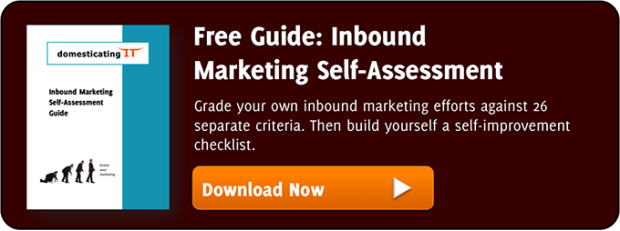
Your Website Is Not a Place to Put Stuff (“Photos of My Life Project- Messiest Closet” by benjamin sTodd on Flickr)
This has been a busy website design week for me. Between proposals and client work, I’ve covered the same topic five or six times. Each conversation began in a different way but they all ended up in the same place.
- We need to make our navigation bar prominent so that visitors can find everything easily.
- How do we organize our home page?
- What’s the difference between web metrics and analytics?
- Why do we need landing pages?
- What’s wrong with a Contact Us page?
Each of these conversations arrived at the same end point; outcome-based website design. What does that mean? It’s a simple philosophy that can completely change the way you think about website design and even shift your thinking about online marketing in general. And it starts by asking yourself one, simple question.
Outcome-Based Website Design
[nonmember]The Inbound Marketing Inquirer is a weekly premium article that’s free to view for members. Create a free account now:
[register_inquirers (free)][/nonmember]
[ismember]
There’s a thought exercise I use with prospects and clients to help them shift into this new mindset. The conversation goes something like this:
Me: Do you have a website?
Them: Yes.
Me: OK, what do you do with it?
Them: Well, we put our products up there and we put our brochures there and we put our press releases there, etc.
Me: That’s not a website, that’s a closet.
A closet is a place where store things and that’s the approach for many website design projects. The goal is to collect all of the information a prospect may ever need and “put” it on the website in a way that he or she can find it as easily as possible. But my problem with this philosophy is that you’re letting the tail wag the dog. The website should be a tool for the organization to achieve its goals, not a utility for the casual visitor.
And so the next step is to ask a different question. Instead of asking “Do you have a website,” what would happen if I asked you, “Do you use a website?” That one, simple word makes all the difference in the world. It creates a whole new mindset that initiates a chain reaction of different thoughts. As soon as you’re asked that question, the next logical one to ask is, “Use it for what?”
Pay dirt! Now you’re starting to ask the right questions:
- How can I use my website to increase revenue and/or decrease costs?
- What do I want a visitor to do when they arrive at my website?
- What does a successful visit look like?
- How can I measure success?
- What targets should I set to achieve my goals?
Now you’re thinking of your website as a tool to get what you want and not a service station for visitors to get what they want. Another way to think of it is a ski resort. They carve trails out of the mountain, then groom and patrol them in order to keep skiers safe and deliver a good experience. Think of your website like ski slopes, which are paths for visitors to arrive at predetermined outcomes you want to happen.
Outcome-based website design is empowering, practical and infectious. Once you think of your website as a tool for achieving outcomes, your entire online marketing strategy starts to fall into place, too. So do you plan to use your website?
[/ismember]
Top Marketing Stories of the Week
What is Branding? And Should Small Businesses Care?
If you spend any time in marketing circles or reading about marketing, you will bump into the word “branding.” This article breaks it down into its constituent parts; awareness, perception, value, identity and loyalty.
7 Simple Copywriting Tweaks That’ll Shoot Your Conversion Rate Up
Is the pen mightier than the sword? In the marketing world, it is. With a few little tweaks to your website copy, you can drastically increase your conversion rate.
Why My Optimized Landing Pages Trump Your SEO Or PPC Landing Pages Every Time!
Landing pages need to be optimized, and optimized pages need to work as solid landing pages. This article looks at how to merge these two types of pages into one optimized landing page.

Trackbacks/Pingbacks